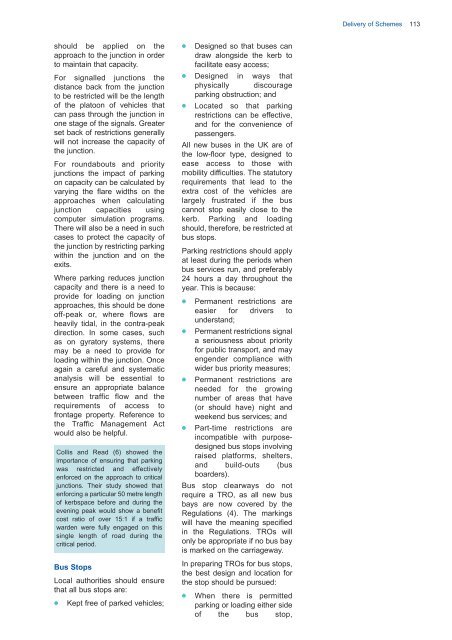titlepage/contents pg 1-16 - British Parking Association
titlepage/contents pg 1-16 - British Parking Association
titlepage/contents pg 1-16 - British Parking Association
Create successful ePaper yourself
Turn your PDF publications into a flip-book with our unique Google optimized e-Paper software.
Delivery of Schemes 113should be applied on theapproach to the junction in orderto maintain that capacity.For signalled junctions thedistance back from the junctionto be restricted will be the lengthof the platoon of vehicles thatcan pass through the junction inone stage of the signals. Greaterset back of restrictions generallywill not increase the capacity ofthe junction.For roundabouts and priorityjunctions the impact of parkingon capacity can be calculated byvarying the flare widths on theapproaches when calculatingjunction capacities usingcomputer simulation programs.There will also be a need in suchcases to protect the capacity ofthe junction by restricting parkingwithin the junction and on theexits.Where parking reduces junctioncapacity and there is a need toprovide for loading on junctionapproaches, this should be doneoff-peak or, where flows areheavily tidal, in the contra-peakdirection. In some cases, suchas on gyratory systems, theremay be a need to provide forloading within the junction. Onceagain a careful and systematicanalysis will be essential toensure an appropriate balancebetween traffic flow and therequirements of access tofrontage property. Reference tothe Traffic Management Actwould also be helpful.Collis and Read (6) showed theimportance of ensuring that parkingwas restricted and effectivelyenforced on the approach to criticaljunctions. Their study showed thatenforcing a particular 50 metre lengthof kerbspace before and during theevening peak would show a benefitcost ratio of over 15:1 if a trafficwarden were fully engaged on thissingle length of road during thecritical period.Bus StopsLocal authorities should ensurethat all bus stops are:● Kept free of parked vehicles;● Designed so that buses candraw alongside the kerb tofacilitate easy access;● Designed in ways thatphysically discourageparking obstruction; and● Located so that parkingrestrictions can be effective,and for the convenience ofpassengers.All new buses in the UK are ofthe low-floor type, designed toease access to those withmobility difficulties. The statutoryrequirements that lead to theextra cost of the vehicles arelargely frustrated if the buscannot stop easily close to thekerb. <strong>Parking</strong> and loadingshould, therefore, be restricted atbus stops.<strong>Parking</strong> restrictions should applyat least during the periods whenbus services run, and preferably24 hours a day throughout theyear. This is because:●●Permanent restrictions areeasier for drivers tounderstand;Permanent restrictions signala seriousness about priorityfor public transport, and mayengender compliance withwider bus priority measures;● Permanent restrictions areneeded for the growingnumber of areas that have(or should have) night andweekend bus services; and● Part-time restrictions areincompatible with purposedesignedbus stops involvingraised platforms, shelters,and build-outs (busboarders).Bus stop clearways do notrequire a TRO, as all new busbays are now covered by theRegulations (4). The markingswill have the meaning specifiedin the Regulations. TROs willonly be appropriate if no bus bayis marked on the carriageway.In preparing TROs for bus stops,the best design and location forthe stop should be pursued:●When there is permittedparking or loading either sideof the bus stop,







